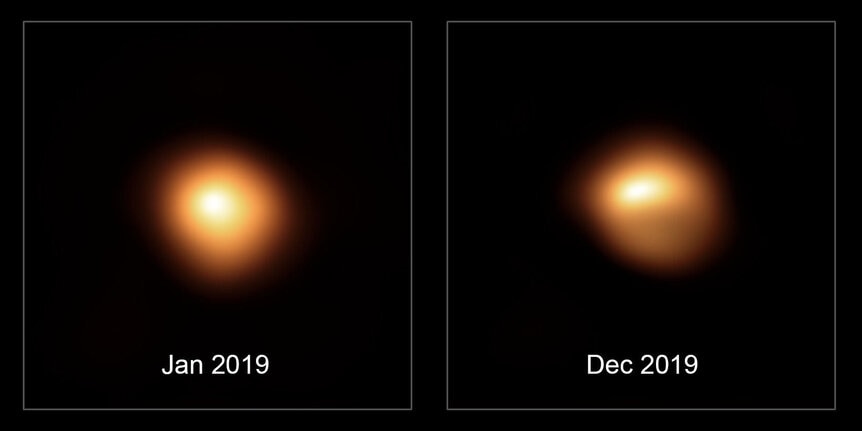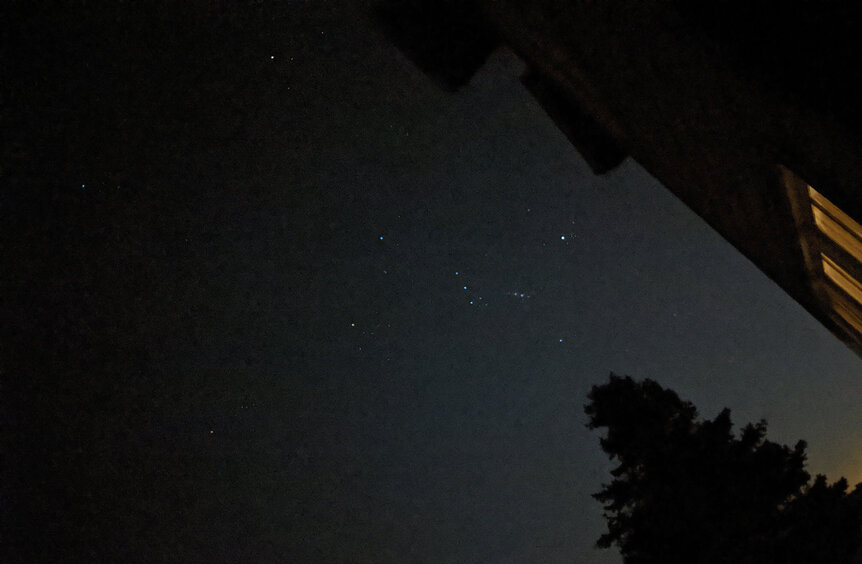Create a free profile to get unlimited access to exclusive videos, sweepstakes, and more!
Don't panic! But Betelgeuse may be 25% closer to Earth than we previously thought

Hey, remember Betelgeuse? It caused quite a kerfuffle both among astronomers and normal people in late 2019 and early 2020 when the star's brightness dropped precipitously. There was much speculation in social media that it might explode, but astronomers knew this was incredibly unlikely. What they were more concerned with was why the star suddenly dimmed so dramatically: What was going on in the upper layers of this enormous star that could make such a huge difference in its light?
It seems pretty clear now that the red supergiant expelled an enormous cloud of dust, which blocks visible light, dimming it substantially. It's not clear why this happened and why on such a huge scale. Massive stars like Betelgeuse have complicated effects going on in their upper layers which can cause the star to physically pulsate, getting bigger and smaller over time. It's likely some other event happened in the star (perhaps a rising plume of hot gas) coupled with the normal pulsation, causing the creation of the dust that dimmed it.
This event, and the efforts to understand it, reminded astronomers that we really don't understand what's going inside this star very well, and in fact there are still basic facts about it we don't know! For example, its size, mass, age, and distance are all extremely difficult to determine.
However, a group of astronomers took a look at some old data of the star to measure its brightness changes, and by feeding them into some complicated models were able to get new estimates of these characteristics. Some of what they found is similar to older estimates, but their estimate of the size of the star has been revised downward quite a bit. The old estimates were it being 1.5 billion kilometers or so across, while the new one is now just over a billion. That's still ginormous, but a lot smaller than previous thinking
But if it's smaller, that means in turn it must be closer to us. They get a number of about 530 light years, 25% closer than previous estimates. That's significant!
Before going on, let me pause and say that if they're correct, and Betelgeuse is closer to us than previously thought, we are still in no danger if it goes supernova. At their new estimated distance it's still way too far away to hurt us if it explodes.
Oh, and the new research indicates it'll be a long, long time before it explodes anyway. Rest easy.
The astronomers wanted to investigate Betelgeuse using physical models of how gas flows inside the star, and how seismic waves travel through it, because these depend on the internal structure of the star (a little like how seismic waves traveling through the Earth tell geologists about the structure inside our planet). The change in brightness in the star over time depends on these factors as well.
The astronomers needed better brightness observations of Betelgeuse to feed their models, so they turned to an unusual source: the Solar Mass Ejection Imager, a detector on the Department of Defense's Coriolis mission. This spacecraft was designed to observe the Sun and get a handle on its activity that can interfere with communications, as you might expect the DoD to be concerned about.
The instrument looked at the Sun, but also observed many bright stars including Betelgeuse. The astronomers reprocessed the data from that mission, providing measurements that filled a gap in observations in the late 2000s, giving them better data to use.
Betelgeuse is known to pulsate on multiple timescales, including one of several years' length and another of just over a year. Using the new data they found those periods to be 2365 days (6.5 years) and 416 days.
The models use that data, and also need things like the initial mass of the star (what mass it was born with; red supergiants lose a lot of mass over time via a process like the solar wind but much more powerful), its age, and so on. Many of these numbers aren't pinned down, so the calculations are run with the input variables varied a little bit each time to see how the end results are changed. So if the initial mass of Betelgeuse is thought to be 18–21 times the Sun then the models are run with a mass of 18, then 18.1 (say), then 18.2, and so on. The results can then be analyzed statistically to see how robust they are.
And that's where the surprises came in. They find the size of the star dropped from something like 1100 times wider than the Sun to just ("just," ha!) 764 times wider. That's a big drop.
But there's more. We can measure Betelgeuse's apparent size on the sky — it's so enormous it's not just an unresolved dot, but can be seen as an actual disk. The size of that disk depends on the distance to the star and its actual, physical size. Now that they had the physical size, they could get the distance, and they found that it's about 530 light years away, when earlier numbers are more like 640.
That's a lot closer! And interesting, if true. Getting the distance to Betelgeuse is surprisingly hard. It's too bright for the Gaia observatory to observe, and other methods yield different values. 530 light years is consistent with old measurements from the Hipparcos satellite, for example, but disagrees with newer ones using radio observatories.
Another interesting outcome of their calculations is that for all this to work, Betelgeuse has to be fusing helium into carbon in its core. Stars like the Sun fuse hydrogen into helium, and massive stars go through that phase in a few million years. After that they fuse helium, which lasts for about 100,000 years before moving onto to carbon fusion. After that the steps take shorter and shorter times, until the star tries to fuse iron, in which case it goes kaboom. Supernova.
So their models indicate it's still in the early stages of helium fusion, which in turn means it won't explode for a long, long time. Whether that makes you impatient or relieved is entirely up to you. I know it's too far to hurt us, so I'm in the former category. I want to see it explode.
So after all this, we still have an important question about this new work: Is it right?
Welllll... that's not easy to say. Their methods are interesting, but all of this is fraught with issues, some of which are really difficult to tease out. Any calculations using models like these have to make a lot of assumptions, and astronomers argue over the validity of those assumptions. Vociferously.
The paper was just published, so I'll keep my eyes open for rebuttals or support. If it's correct then it will change a lot of what we think about red supergiant stars, and Betelgeuse in particular. That's OK! Scientists don't mind that sort of thing in general, because it means we're learning, we're getting closer to the truth, we're converging on consensus. We all have our pet ideas, of course, and will defend them. But over time new ideas and new methods tend to steer us in the right direction. Hopefully we'll grok Betelgeuse a lot better in the coming years.






























